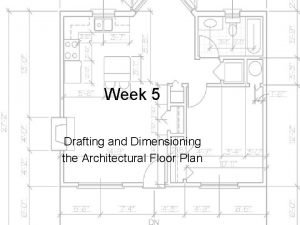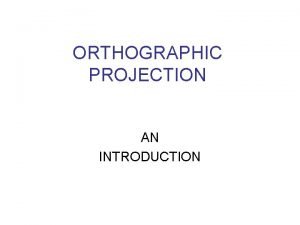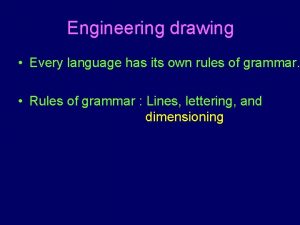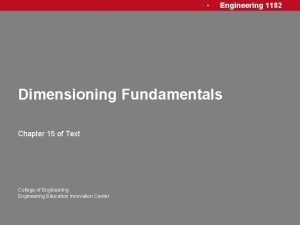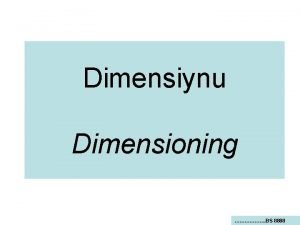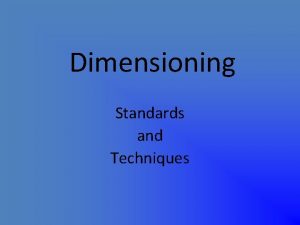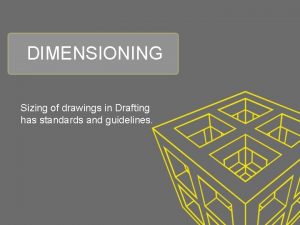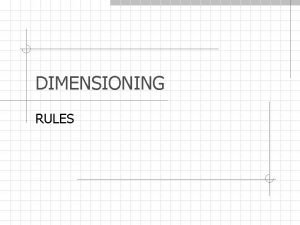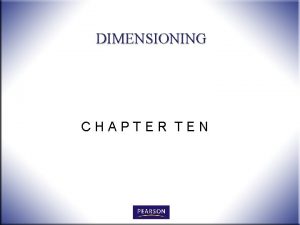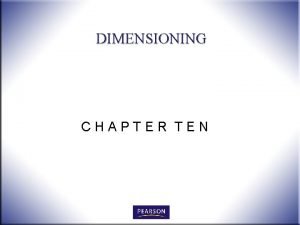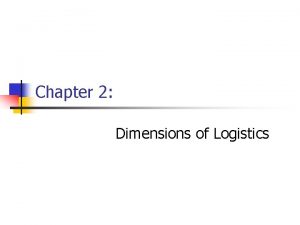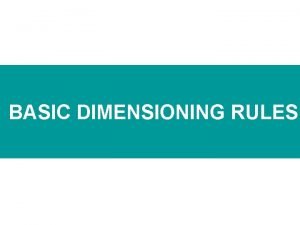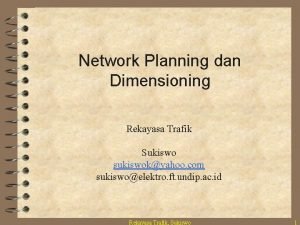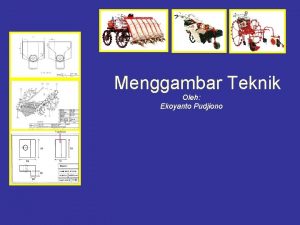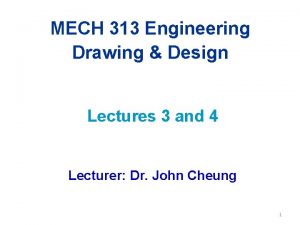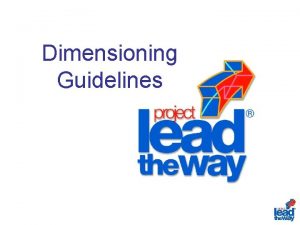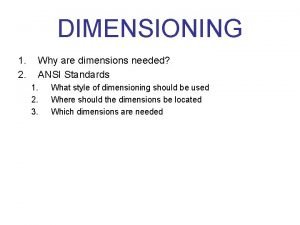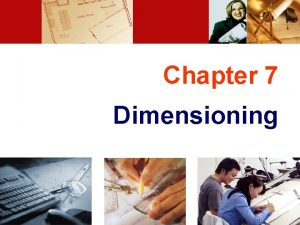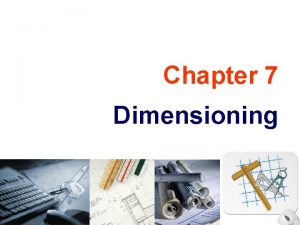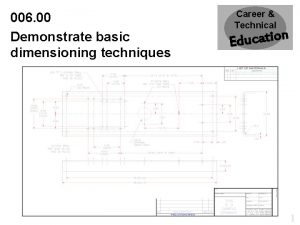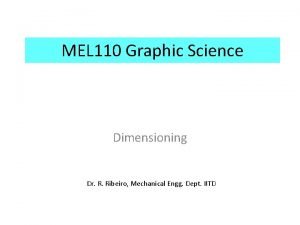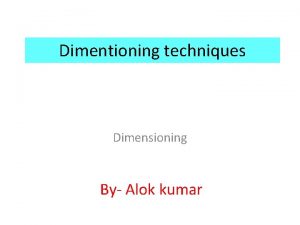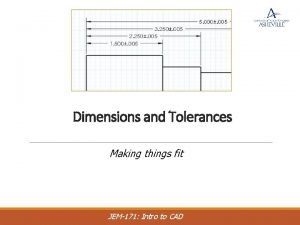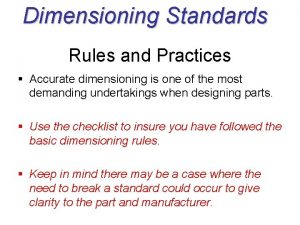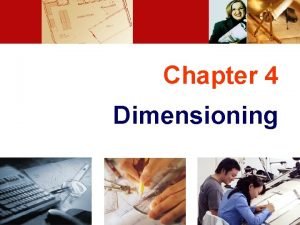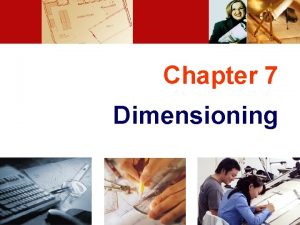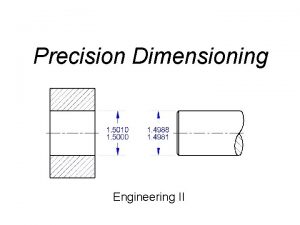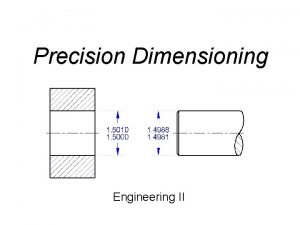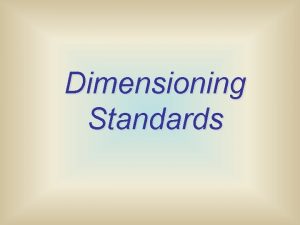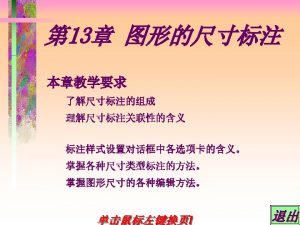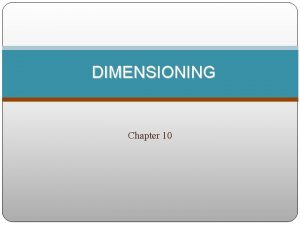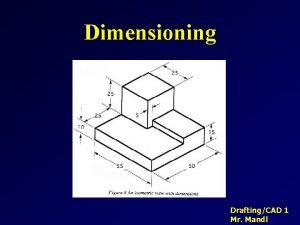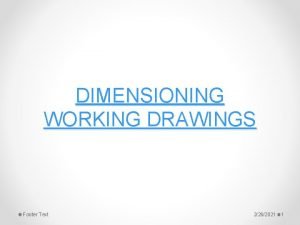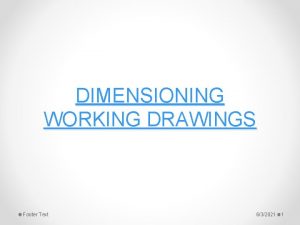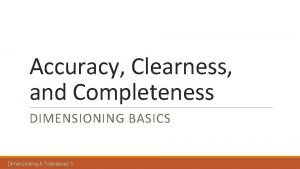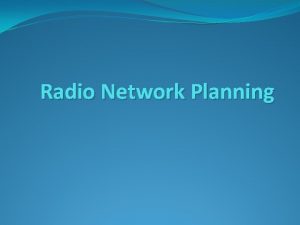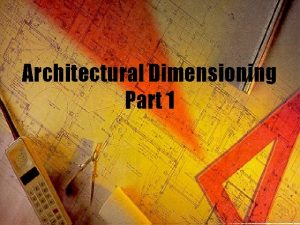Dimensioning Practices ANGLE To dimension an angle use




























- Slides: 28


Dimensioning Practices

ANGLE To dimension an angle use circular dimension line having the center at the vertex of the angle. COMMON MISTAKE

ARC Arcs are dimensioned by giving the radius, in the views in which their true shapes appear. The letter “R” is always lettered before the figures to emphasize that this dimension is radius of an arc. 00 2 R or

ARC The dimension figure and the arrowhead should be inside the arc, where there is sufficient space. Sufficient space for arrowhead only. Insufficient space for both. Move figure outside Move both figure and arrow outside R 62. 5 R 6. 5 R 20 0 Sufficient space for both. R 58. 5

ARC Use the foreshortened radial dimension line, when arc’ s center locates outside the sheet or interfere with other views. Method 2 1 Drawing sheet

ARC Leader line must be radial and inclined with an angle between 30 ~ 60 degs. to the horizontal. COMMON MISTAKE R 62. 5 o 60 R 62. 5 o 30 R 62. 5

FILLETS AND ROUNDS Give the radius of a typical fillet only by using a local note. If all fillets and rounds are uniform in size, dimension may be omitted, but it is necessary to add the note “ All fillets and round are Rxx. ” R 6. 5 R 12 NOTE: All fillets and round are R 6. 5 Drawing sheet NOTE: All fillets and round are R 6. 5 unless otherwise specified.

CURVE The curve constructed from two or more arcs, requires the dimensions of radii and center’s location. COMMON MISTAKE Tangent point

CYLINDER Size dimensions are diameter and length. Location dimension must be located from its center lines and should be given in circular view. Measurement method

CYLINDER Diameter should be given in a longitudinal view 70 100 with the symbol “ ” placed before the figures.

HOLES Size dimensions are diameter and depth. Location dimension must be located from its center lines and should be given in circular view. Measurement method

HOLES : SMALL SIZE Use leader line and local note to specify diameter and hole’s depth in the circular view. 1) Through thickness hole xx Thru. xx or or xx Drill, Thru.

HOLES : SMALL SIZE Use leader line and local note to specify diameter and hole’s depth in the circular view. 2) Blind hole xx, yy Deep or Hole’s depth xx Drill, yy Deep

HOLES : LARGE Use extension and dimension lines xx Use diametral dimension line SIZE Use leader line and note

HOLES COMMON MISTAKE xx Rxx xx xx

CHAMFER Use leader line and note to indicate linear distance and angle of the chamfer. q S For a 45 o chamfer or CS S S

Placement of Dimensions

RECOMMENDED PRACTICE 1. Extension lines, leader lines should not cross dimension lines. POOR GOOD

RECOMMENDED PRACTICE 2. Extension lines should be drawn from the nearest points to be dimensioned. POOR GOOD

RECOMMENDED PRACTICE 3. Extension lines of internal feature can cross visible lines without leaving a gap at the intersection point. WRONG CORRECT

RECOMMENDED PRACTICE 4. Do not use object line, center line, and dimension line as an extension lines. POOR GOOD

RECOMMENDED PRACTICE 5. Avoid dimensioning hidden lines. POOR GOOD

RECOMMENDED PRACTICE 6. Place dimensions outside the view, unless placing them inside improve the clarity. POOR GOOD

RECOMMENDED PRACTICE 7. Apply the dimension to the view that clearly show the shape or features of an object. POOR GOOD

RECOMMENDED PRACTICE 8. Dimension lines should be lined up and grouped together as much as possible. POOR GOOD

RECOMMENDED PRACTICE 9. Do not repeat a dimension. POOR GOOD

END
 Wall thickness in floor plan
Wall thickness in floor plan Baseline dimensioning definition
Baseline dimensioning definition What is orthographic projection *
What is orthographic projection * In unidirectional system the dimensions are
In unidirectional system the dimensions are B. superimposed running dimensioning
B. superimposed running dimensioning Dimensioning a cylinder
Dimensioning a cylinder Combined dimensioning
Combined dimensioning Dimensioning standards
Dimensioning standards Dimensioning in drafting
Dimensioning in drafting Dimensioning rules
Dimensioning rules Superfluous dimensions
Superfluous dimensions This is a thin solid line directing attention
This is a thin solid line directing attention Garis dimensi gambar teknik
Garis dimensi gambar teknik Dimensions of logistics
Dimensions of logistics Basic dimensioning rules
Basic dimensioning rules Dimensioning adalah
Dimensioning adalah Superimposed gambar adalah
Superimposed gambar adalah Tabular dimensioning
Tabular dimensioning Dimensioning guidelines
Dimensioning guidelines Ansi dimensioning standards
Ansi dimensioning standards Dimensioning components includes
Dimensioning components includes Dimensioning components includes
Dimensioning components includes Dimensioning techniques
Dimensioning techniques What line types are usually omitted from sectional views
What line types are usually omitted from sectional views Aligned system dimensioning
Aligned system dimensioning Progressive dimensioning
Progressive dimensioning Dimensions
Dimensions Hole dimensioning standards
Hole dimensioning standards Dimensioning standards
Dimensioning standards
